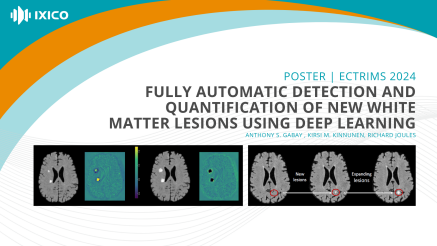Fully automatic detection and quantification of new white matter lesions using deep learning

Accurate detection, segmentation, and quantification of lesion dynamics in longitudinal MRI is crucial for monitoring disease progression in Multiple Sclerosis, and for evaluating the efficacy of therapeutic interventions. We present an efficient, automatic method utilising deep learning to assess lesion changes in FLAIR MRI with a high degree of accuracy.
Our new methodology performs well in identifying new lesions in a simulated dataset, is sensitive to lesion dynamics, and outperforms simpler methods of subtracting cross-sectionally derived lesion volumes.
Method
We retrained VoxelMorph, a deep learning model which estimates deformation flow fields between image pairs, on 200 FLAIR image pairs from ADNI, with interscan intervals between 1 and 3 years. This model was used to estimate the deformation fields between the follow-up and baseline images.
We retrained LG-Net, a deep learning algorithm for T1W lesion inpainting, to artificially generate new and expanding lesions for 45 FLAIR images. We simulated between 1 and 5 new lesions per dataset, with each lesion ranging between 50mm3 and 500mm3.
Results
New lesions identified by the pipeline were considered a true positive if they overlapped >50% with the ground truth lesion mask. The method showed excellent performance and successfully identified new lesions across a range of lesion sizes.
Presented at ECTRIMS 2024
Download